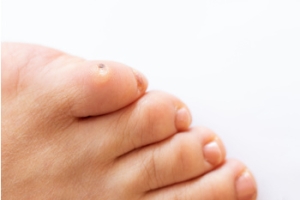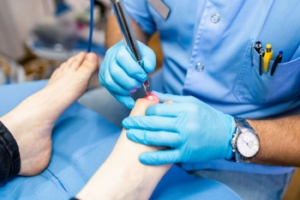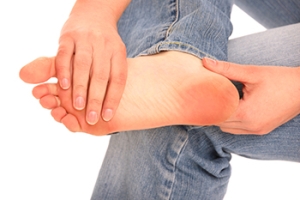
How to Identify and Treat a Foot Corn
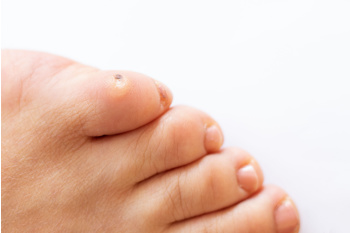
Corns, those pesky patches of thickened skin, can turn a simple walk into agony. Identifying them is key. Look for hardened areas on toes or feet, often with a cone-like shape pointing inward. They are caused by friction and pressure, typically from wearing ill-fitting shoes or repetitive actions. Treating corns involves gentle methods like soaking the feet in warm water, using a pumice stone to smooth the area, and moisturizing to prevent recurrence. Avoid over-the-counter corn removal products, as they can damage healthy skin. For persistent corns, or if you are unsure about treatment, it is wise to seek advice from a podiatrist. They can provide professional care, assess your foot health, and recommend appropriate courses of action. Do not let corns slow you down. It is suggested that you schedule an appointment with a podiatrist for personalized guidance and relief.
Corns can make walking very painful and should be treated immediately. If you have questions regarding your feet and ankles, contact one of our podiatrists of Foot Doctors of Utica. Our doctors will treat your foot and ankle needs.
Corns: What Are They? And How Do You Get Rid of Them?
Corns are thickened areas on the skin that can become painful. They are caused by excessive pressure and friction on the skin. Corns press into the deeper layers of the skin and are usually round in shape.
Ways to Prevent Corns
There are many ways to get rid of painful corns such as:
- Wearing properly fitting shoes that have been measured by a professional
- Wearing shoes that are not sharply pointed or have high heels
- Wearing only shoes that offer support
Treating Corns
Although most corns slowly disappear when the friction or pressure stops, this isn’t always the case. Consult with your podiatrist to determine the best treatment option for your case of corns.
If you have any questions, please feel free to contact our offices located in Herkimer, and New Hartford, NY . We offer the newest diagnostic and treatment technologies for all your foot care needs.
Understanding Corns and Calluses
Corns and Calluses are both hardened layers of thickened skin that develop because of friction. Both ailments are typically found on the feet and may be unsightly. Although they have similarities, corns and calluses are different from each other.
Some causes of corns and calluses may be wearing ill-fitting shoes and not wearing socks. If you wear tight shoes, your feet will constantly be forced to rub against the shoes, causing friction. If you fail to wear socks, you are also causing your feet to endure excess friction.
There are some signs that may help you determine whether you have one of these two conditions. The first symptom is a thick, rough area of skin. Another common symptom is a hardened, raised bump on the foot. You may also experience tenderness or pain under the skin in addition to flaky, dry, or waxy skin.
There are also risk factors that may make someone more prone to developing corns and calluses. If you are already dealing with bunions or hammertoe, you may be more vulnerable to having corns and calluses as well. Other risk factors are foot deformities such as bone spurs, which can cause constant rubbing inside the shoe.
Corns tend to be smaller than calluses and they usually have a hard center surrounded by inflamed skin. They also tend to develop on the parts of the body that don’t bear as much weight such as the tops and sides of toes. Corns may also be painful for those who have them. On the other hand, calluses are rarely painful. These tend to develop on the bottom of the feet and may vary in size and shape.
Fortunately, most people only need treatment for corns and calluses if they are experiencing discomfort. At home treatments for corns and calluses should be avoided, because they will likely lead to infection. If you have either of these ailments it is advised that you consult with your podiatrist to determine the best treatment option for you.
How Poor Circulation Affects Your Feet
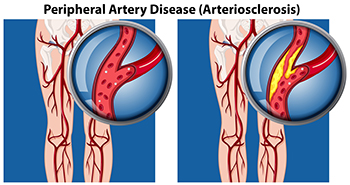
Poor circulation, particularly from peripheral artery disease, or PAD, can significantly affect the health of your feet. PAD occurs when arteries narrow, reducing blood flow to the extremities, most commonly affecting the legs and feet. This diminished blood flow can cause leg pain, numbness, and weakness, which often worsen during physical activity and may persist even at rest. Additional symptoms can include cold feet, pale skin, and changes in toenail health, such as slower growth, thickening, deformation, or discoloration. These issues arise because the reduced blood flow prevents your feet from receiving adequate oxygen and nutrients. In severe cases, PAD can lead to critical limb ischemia, where chronic lack of blood flow results in ulcers, gangrene, and tissue damage. Managing PAD typically involves lifestyle modifications, such as quitting smoking, exercising regularly, and controlling diabetes. If you experience any signs of poor circulation in your feet, it is suggested that you schedule an appointment with a podiatrist for a diagnosis and effective treatment plan to prevent serious complications.
It is important to find shoes that fit you properly in order to avoid a variety of different foot problems. For more information about treatment, contact one of our podiatrists from Foot Doctors of Utica. Our doctors will treat your foot and ankle needs.
Proper Shoe Fitting
Shoes have many different functions. They cushion our body weight, protect our feet, and allow us to safely play sports. You should always make sure that the shoes you wear fit you properly in order to avoid injuries and deformities such as: bunions, corns, calluses, hammertoes, plantar fasciitis, stress fractures, and more. It is important to note that although a certain pair of shoes might be a great fit for someone else, that doesn’t mean they will be a great fit for you. This is why you should always try on shoes before buying them to make sure they are worth the investment. Typically, shoes need to be replaced ever six months to one year of regular use.
Tips for Proper Shoe Fitting
- Select a shoe that is shaped like your foot
- Don’t buy shoes that fit too tight, expecting them to stretch to fit
- Make sure there is enough space (3/8” to ½”) for your longest toe at the end of each shoe when you are standing up
- Walk in the shoes to make sure they fit and feel right
- Don’t select shoes by the size marked inside the shoe, but by how the shoe fits your foot
The shoes you buy should always feel as good as they look. Shoes that fit properly will last longer, feel better, and improve your way of life each day.
If you have any questions, please feel free to contact our offices located in Herkimer, and New Hartford, NY . We offer the newest diagnostic and treatment technologies for all your foot care needs.
How to Get a Proper Shoe Fit
Many people suffer from foot problems because their shoes are poorly fitted. When shopping for a new pair of shoes, fashion usually triumphs over comfortability. A pair of well fitted shoes is essential in preventing foot problems and potential injuries.
Poorly fitted shoes can cause foot issues such as plantar fasciitis, bunions, hammertoes, ingrown toenails, and foot pain. Shoes such as high heels and sandals may cause problems for your feet. These shoes put the foot in an unnatural position for long periods and fail to provide good foot support. It is recommended to not wear either one for an extended period.
When you are trying on shoes, make sure they have enough space for your toes to move around. Shoes shouldn’t be cramped but also shouldn’t have too much room that your foot moves around in them. A snug shoe is a good choice. They should also provide good arch support and cushioning. Athletic shoes tend to offer both good support and cushioning. A degree of flexibility is necessary so they aren’t too stiff or too unsupportive.
If you can wear your shoes for a long period of time without experiencing any discomfort, this is a sign that your shoes fit properly. Do not be too dismayed if the shoe isn’t a perfect fit at first; many shoes take a few days to weeks to properly break in. However don’t expect an uncomfortable shoe to become fitted to your foot.
For those with foot conditions such as flat feet or pronation, orthotics may be helpful or even necessary to prevent foot pain. Orthotics are inserts that are placed in the shoe and provide support and cushioning for the foot. While there are many types of orthotics out there, custom-made orthotics may be necessary depending upon your foot and foot conditions.
Feet change in size over time. It is important to check your foot size over time so that you can make sure you have the perfect fit for your feet. A podiatrist can provide more information on proper shoe fitting and foot orthotics.
Safety and Effectiveness of Laser Treatment for Toenail Fungus
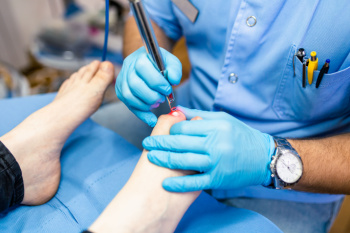 Laser treatment for toenail fungus involves using focused light beams to target and eliminate fungal infections in the nail bed. This non-invasive procedure is considered both safe and effective, offering a promising alternative to traditional antifungal medications. The laser penetrates the nail to reach the underlying fungus, disrupting its growth and ultimately destroying it. Many patients experience significant improvement after just a few sessions, with minimal side effects. Unlike oral medications, laser treatment does not carry the risk of systemic side effects, making it a suitable option for those who cannot tolerate pharmaceuticals. While results can vary, and complete eradication may require multiple treatments, laser therapy remains a highly viable method for combating stubborn toenail fungus. If you have developed toenail fungus, it is suggested that you consult a podiatrist who can determine if laser treatment is the correct treatment option for you.
Laser treatment for toenail fungus involves using focused light beams to target and eliminate fungal infections in the nail bed. This non-invasive procedure is considered both safe and effective, offering a promising alternative to traditional antifungal medications. The laser penetrates the nail to reach the underlying fungus, disrupting its growth and ultimately destroying it. Many patients experience significant improvement after just a few sessions, with minimal side effects. Unlike oral medications, laser treatment does not carry the risk of systemic side effects, making it a suitable option for those who cannot tolerate pharmaceuticals. While results can vary, and complete eradication may require multiple treatments, laser therapy remains a highly viable method for combating stubborn toenail fungus. If you have developed toenail fungus, it is suggested that you consult a podiatrist who can determine if laser treatment is the correct treatment option for you.
Laser treatment can be an effective way to get rid of toenail fungus. If you have any questions about laser treatment, consult with one of our podiatrists from Foot Doctors of Utica. Our doctors will assess your condition and provide you with quality treatment for fungal nails.
What Are Toenail Fungal Infections?
Onychomycosis, or fungal infection of the nail, is a relatively common and non-serious condition. Around 10 percent of U.S. citizens are afflicted with fungal nails. Common forms of fungus that infect the nail include dermatophytes, yeasts, and molds.
Symptoms of Toenail Fungal Infections Include:
- Nail thickening
- Brittleness of the nail
- Discoloration of the nail
Diagnosis for Fungal Nails
Fungal infections are diagnosed by fungal culture and microscopy. This will rule out any other conditions such as nail trauma, psoriasis, lichen planus, and onychogryphosis.
What Is Laser Treatment?
Laser treatment is a non-invasive, safe, quick, and painless procedure that uses the heat from a laser to kill fungus in the nail. Each infected nail is targeted with a laser for several minutes. The treatment is usually utilized several different times over a select period. During this time, a podiatrist will keep an eye on the infection.
If you have any questions, please feel free to contact our offices located in Herkimer, and New Hartford, NY . We offer the newest diagnostic and treatment technologies for all your foot care needs.
Laser Treatment for Fungal Nails
A new treatment for fungal nails, or onychomycosis, which has grown in popularity in recent years, is laser treatment. Laser treatment involves the use of a laser that kills fungus in the toenail with heat. Laser therapy causes no side effects and does not affect nearby healthy tissue.
Toenail fungus afflicts almost 10 percent of the U.S. population and is more common among the elderly. The most common symptom of toenail fungus is the discoloration and thickening of the nail. The nail can also become brittle and a foul smell may be produced. In rare cases, pain might be present. While it is not a serious condition, it can lead to a perception of disgust amongst those it affects. There are several different fungi that cause fungal infections. These include dermatophyte, yeast, and mold. The most common of these is dermatophyte.
Diagnosis for fungal nails involves a podiatrist utilizing microscopy and fungal cultures. This will allow the doctor to determine whether it is a fungus or another condition, such as lichen planus, psoriasis, nail damage, and onychogryphosis.
Fungus in the nails can be hard to get rid of with over-the-counter drugs. This is due to the nail being hard and protective, with fungus able to slip between the nail bed and plate. Furthermore the slow growth of the nail increases the difficulty of fungus going away. Laser treatment seeks to get around this by directly penetrating through the nail and killing the fungus. The laser is used on each infected nail for a couple of minutes. Patients then typically return several weeks or months later for another laser treatment. During this time the podiatrist will routinely observe the foot and infection. It is also recommended to wear clean socks and shoes and allow the feet to dry and breathe to prevent toenail fungus.
Laser treatment is still a relatively new treatment and not all podiatrists have laser machines. Ask your podiatrist if they do laser treatment for toenail fungus and if it is right for you.
Apophysitis and Osteochondrosis
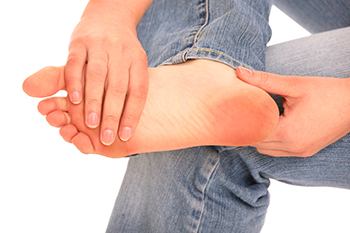 Apophysitis and osteochondrosis are common causes of pain in growing bones, often affecting children and teenagers. Apophysitis happens when growth plates, the areas where bones grow, become irritated from overuse or stress, sometimes affecting the feet. Osteochondrosis occurs when the bone underneath a joint's cartilage does not get enough blood, leading to pain and inflammation. These conditions usually occur during growth spurts, when bones, muscles, and tendons are rapidly changing. Activities like running, jumping, or participating in sporting activities can put extra stress on these growing areas. Symptoms can include pain, swelling, and tenderness near the affected bone or joint. The pain might worsen with activity and improve with rest. Treatment involves resting the affected area. Stretching and strengthening exercises, guided by a podiatrist, can also help. If your child is suffering from any kind of foot pain, it is suggested that you schedule an appointment with a podiatrist for an evaluation and appropriate treatment.
Apophysitis and osteochondrosis are common causes of pain in growing bones, often affecting children and teenagers. Apophysitis happens when growth plates, the areas where bones grow, become irritated from overuse or stress, sometimes affecting the feet. Osteochondrosis occurs when the bone underneath a joint's cartilage does not get enough blood, leading to pain and inflammation. These conditions usually occur during growth spurts, when bones, muscles, and tendons are rapidly changing. Activities like running, jumping, or participating in sporting activities can put extra stress on these growing areas. Symptoms can include pain, swelling, and tenderness near the affected bone or joint. The pain might worsen with activity and improve with rest. Treatment involves resting the affected area. Stretching and strengthening exercises, guided by a podiatrist, can also help. If your child is suffering from any kind of foot pain, it is suggested that you schedule an appointment with a podiatrist for an evaluation and appropriate treatment.
Foot Pain
Foot pain can be extremely painful and debilitating. If you have a foot pain, consult with one of our podiatrists from Foot Doctors of Utica. Our doctors will assess your condition and provide you with quality foot and ankle treatment.
Causes
Foot pain is a very broad condition that could be caused by one or more ailments. The most common include:
- Bunions
- Hammertoes
- Plantar Fasciitis
- Bone Spurs
- Corns
- Tarsal Tunnel Syndrome
- Ingrown Toenails
- Arthritis (such as Gout, Rheumatoid, and Osteoarthritis)
- Flat Feet
- Injury (from stress fractures, broken toe, foot, ankle, Achilles tendon ruptures, and sprains)
- And more
Diagnosis
To figure out the cause of foot pain, podiatrists utilize several different methods. This can range from simple visual inspections and sensation tests to X-rays and MRI scans. Prior medical history, family medical history, and any recent physical traumatic events will all be taken into consideration for a proper diagnosis.
Treatment
Treatment depends upon the cause of the foot pain. Whether it is resting, staying off the foot, or having surgery; podiatrists have a number of treatment options available for foot pain.
If you have any questions, please feel free to contact our offices located in Herkimer, and New Hartford, NY . We offer the newest diagnostic and treatment technologies for all your foot care needs.
Foot Pain
The feet, being the foundation of the body, carry all of the body’s weight and are therefore prone to experiencing pain and discomfort. If you are experiencing foot pain, it is important to determine where in the foot you are experiencing this pain to help discover the cause of it. While pain can be experienced virtually anywhere in the foot, the most common sites of foot pain are in the heel and ankle.
Heel pain can be due to a multitude of conditions including plantar fasciitis, Achilles tendinitis, and heel spurs. Pain experienced in the ankle can be a sign of an ankle sprain, arthritis, gout, ankle instability, ankle fracture, or nerve compression. In more serious cases, pain in the foot can be a sign of improper alignment or an infection.
Foot pain can be accompanied by symptoms including redness, swelling, stiffness and warmth in the affected area. Whether the pain can be described as sharp or dull depends on the foot condition behind it. It is important to visit your local podiatrist if your foot pain and its accompanying symptoms persist and do not improve over time.
Depending on the location and condition of your foot pain, your podiatrist may prescribe certain treatments. These treatments can include but are not limited to prescription or over-the-counter drugs and medications, certain therapies, cortisone injections, or surgery.
If you are experiencing persistent foot pain, it is important to consult with your foot and ankle doctor to determine the cause and location. He or she will then prescribe the best treatment for you. While milder cases of foot pain may respond well to rest and at-home treatments, more serious cases may take some time to fully recover.
Stages of Children's Feet From Pre-Crawling to School

Children's feet go through various stages of development, each requiring specific care and attention. During the pre-crawling stage, infants have soft, pliable feet that need freedom to move and grow, so bare feet or socks are ideal. For newborns, shoes are not necessary, but soft, flexible booties can provide warmth. As babies start taking their first steps, known as the first walker stage, they need lightweight, flexible shoes that allow natural foot movement and provide protection. In preschool, children become more active, necessitating sturdy shoes that offer support and durability. By the time they reach school age, kids' feet have developed arches and require well-fitting shoes that support prolonged periods of walking and running. If you have questions regarding your child’s foot development, it is suggested that you consult a podiatrist who can address any concerns you may have.
Making sure that your children maintain good foot health is very important as they grow. If you have any questions, contact one of our podiatrists of Foot Doctors of Utica. Our doctors can provide the care you need to keep you pain-free and on your feet.
Keeping Children's Feet Healthy
Having healthy feet during childhood can help prevent medical problems later in life, namely in the back and legs. As children grow, their feet require different types of care. Here are some things to consider...
Although babies do not walk yet, it is still very important to take care of their feet.
Avoid putting tight shoes or socks on his or her feet.
Allow the baby to stretch and kick his or her feet to feel comfortable.
As a toddler, kids are now on the move and begin to develop differently. At this age, toddlers are getting a feel for walking, so don’t be alarmed if your toddler is unsteady or ‘walks funny’.
As your child gets older, it is important to teach them how to take care of their feet.
Show them proper hygiene to prevent infections such as fungus.
Be watchful for any pain or injury.
Have all injuries checked by a doctor as soon as possible.
Comfortable, protective shoes should always be worn, especially at play.
If you have any questions please feel free to contact our offices located in Herkimer, and New Hartford, NY . We offer the newest diagnostic and treatment technologies for all your foot and ankle needs.
